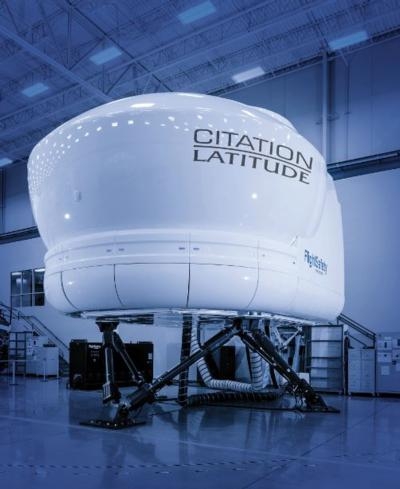Sat, Sep 26, 2015
First Device Ready For Use In Wichita, Second Planned For Ohio Next Year
Training using the first Cessna Citation Latitude Level D simulator to be operated by FlightSafety is scheduled to begin in Wichita next week. FlightSafety’s second simulator for the Citation Latitude will be installed at the company’s Learning Center in Columbus, Ohio next year.

“We are pleased to offer the most complete range of Cessna aircraft training programs delivered by our team of highly qualified and experienced instructors,” said David Davenport, Executive Vice President. “The Citation Latitude training program benefits from FlightSafety’s 40 years of experience with Cessna aircraft training and industry-leading advances in simulation and training technology.”
The first simulator is located at FlightSafety’s Cessna Pilot Learning Center in Wichita, Kansas and is equipped with the Garmin G5000 avionics system. It has been qualified to Level D by the United States Federal Aviation Administration. Qualification by the European Aviation Safety Agency is scheduled to be completed early next year. “Building two Citation Latitude full flight simulators demonstrates our long-term commitment to provide our Customers with the training programs they require and to deliver industry-leading service and support,” added David Davenport.
The FlightSafety FS1000 simulators for the Citation Latitude are designed to replicate the exact flight and performance characteristics of the aircraft. They offer advanced instructional capabilities and are designed for maximum reliability, ease of maintenance and support. The simulators include FlightSafety’s new Instruction Operating Station designed to provide instructors with a highly productive and efficient work space. It features an intuitive interface, scalable graphics, and large multi touch displays.
They are also equipped with FlightSafety’s VITAL 1100 visual system. Its unprecedented fidelity significantly enhances training by providing highly detailed mission specific imagery with vastly improved scene content and exceptional environmental effects. Pilots also benefit from photo-realistic imagery up to 40 -million-pixel-resolution, and wide field of views designed to enhance training realism.
(Image provided with FlightSafety International news release)
More News
He Attempted To Restart The Engine Three Times. On The Third Restart Attempt, He Noticed That Flames Were Coming Out From The Right Wing Near The Fuel Cap Analysis: The pilot repor>[...]
Make Sure You NEVER Miss A New Story From Aero-News Network Do you ever feel like you never see posts from a certain person or page on Facebook or Instagram? Here’s how you c>[...]
From 2009 (YouTube Edition): Leading Air Show Performers Give Their Best Advice for Newcomers On December 6th through December 9th, the Paris Las Vegas Hotel hosted over 1,500 air >[...]
Aero Linx: NASA ASRS ASRS captures confidential reports, analyzes the resulting aviation safety data, and disseminates vital information to the aviation community. The ASRS is an i>[...]
“For our inaugural Pylon Racing Seminar in Roswell, we were thrilled to certify 60 pilots across our six closed-course pylon race classes. Not only did this year’s PRS >[...]
 NTSB Final Report: Rutan Long-EZ
NTSB Final Report: Rutan Long-EZ ANN FAQ: Turn On Post Notifications
ANN FAQ: Turn On Post Notifications Classic Aero-TV: ICAS Perspectives - Advice for New Air Show Performers
Classic Aero-TV: ICAS Perspectives - Advice for New Air Show Performers ANN's Daily Aero-Linx (06.28.25)
ANN's Daily Aero-Linx (06.28.25) Aero-News: Quote of the Day (06.28.25)
Aero-News: Quote of the Day (06.28.25)



